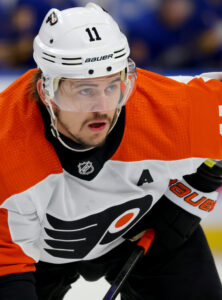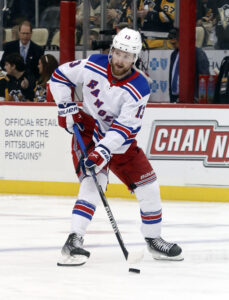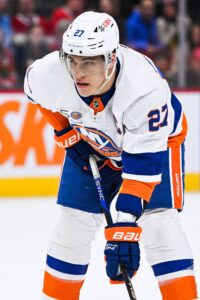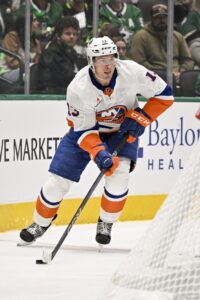Navigating the salary cap is one of the most important tasks for a front office. Teams that can avoid total cap chaos by walking the tightrope of inking players to deals that match their value (or compensate for future value without breaking the bank) remain successful. Those who don’t often see struggles and front office changes.
PHR will look at every NHL team and give a thorough look at their cap situation for the 2025-26 season. This will focus more on players who are regulars on the roster versus those who may find themselves shuttling between the AHL and NHL. All cap figures are courtesy of PuckPedia. We’re currently covering the Metropolitan Division, next up are the Flyers.
Philadelphia Flyers
Current Cap Hit: $95,129,762 (below the $95.5MM Upper Limit)
Entry-Level Contracts
F Alex Bump (three years, $950K)
F Nikita Grebenkin (one year, $875K)
F Jett Luchanko (three years, $942.5K)
F Matvei Michkov (two years, $950K)
Potential Bonuses
Luchanko: $400K
Michkov: $3.3MM
Total: $3.7MM
 Michkov was able to come to North America two years earlier than expected and didn’t disappoint. While there were some ups and downs, that’s to be expected from a rookie while his 63 points led all rookie forwards (though he finished fourth in Calder Trophy voting). Michkov appears to be well on his way to becoming the type of franchise winger Philadelphia hoped he’d be when they drafted him in 2023 and if he lives up to the hype, a long-term contract could run the Flyers upwards of $9MM. He maxed out on his four ‘A’ bonuses worth $250K apiece last season and as long as he stays healthy, he should be able to do so again this season. The rest of the bonuses are ‘B’ ones and those are unlikely to be reached.
Michkov was able to come to North America two years earlier than expected and didn’t disappoint. While there were some ups and downs, that’s to be expected from a rookie while his 63 points led all rookie forwards (though he finished fourth in Calder Trophy voting). Michkov appears to be well on his way to becoming the type of franchise winger Philadelphia hoped he’d be when they drafted him in 2023 and if he lives up to the hype, a long-term contract could run the Flyers upwards of $9MM. He maxed out on his four ‘A’ bonuses worth $250K apiece last season and as long as he stays healthy, he should be able to do so again this season. The rest of the bonuses are ‘B’ ones and those are unlikely to be reached.
Luchanko surprised many by making the roster out of training camp last season and with at least one forward spot likely up for grabs this time around, he could be in the mix again this year although that nine-game threshold will loom large. That won’t apply for Bump and Grebenkin who should also be in the mix. Luchanko (technically) and Bump haven’t started their contracts yet so it’d be foolhardy to project their next ones while Grebenkin is likely heading for a bridge deal. A one-way pact that keeps the cap hit a little lower – somewhere a little above what he’s making now – would make sense.
Signed Through 2025-26, Non-Entry-Level
F Rodrigo Abols ($800K, UFA)
F Bobby Brink ($1.5MM, RFA)
F Nicolas Deslauriers ($1.75MM, UFA)
D Jamie Drysdale ($2.3MM, RFA)
F Christian Dvorak ($5.4MM, UFA)
G Samuel Ersson ($1.45MM, RFA)
G Ivan Fedotov ($3.275MM, UFA)
D Dennis Gilbert ($775K, UFA)
D Noah Juulsen ($900K, UFA)
D Egor Zamula ($1.55MM, RFA)
F Trevor Zegras ($5.75MM, RFA)
The Ducks decided to pull the plug on Zegras, allowing Philadelphia to step in with an offer that many would qualify as underwhelming but it was enough to get him. He is coming off another injury-riddled season while producing at a 46-point pace, well below the two seasons of 60-plus points he has under his belt from earlier in his career. That, coupled with a high-priced bridge deal, hurt his value. Owed $5.75MM for a qualifying offer with arbitration rights, another season like his last two will make him a non-tender candidate or a club-elected arbitration candidate where they could offer a 15% cut in pay. Dvorak comes over from Montreal in one of the bigger overpayments of the summer for a player who has yet to reach 40 points in his career. However, getting him just on a one-year deal as a bridge veteran required the overpayment. If he can play at a similar level as last season, a multi-year pact in the $4MM range shouldn’t be out of reach if he opts not to do another above-market one-year agreement.
Deslauriers played quite sparingly last season and when he was in the lineup, playing time was rather hard to come by. He was an every-game player when he first joined Philadelphia but that’s no longer the case. Enforcers can still generate some open-market interest but he should check in closer to the minimum salary next summer. Year one of Brink’s bridge deal went quite nicely as he upped his production to 41 points. Assuming he stays around that number, he’ll have a chance at doubling his current price tag with arbitration rights. Abols got his first taste of NHL action last season and the Flyers saw fit to hand him a small raise on a one-way deal, suggesting that they view him as a roster regular this year. At 29, it’s a bit late for a breakout year but if he can grab a full-time spot and have some success, getting a seven-figure pact next summer might be achievable.
Drysdale managed to stay healthier last season compared to the previous two seasons but staying in the lineup on an every-game basis continues to be a challenge. He still has three more RFA years left which presents an opportunity for effectively a second bridge deal next summer. If that happens, he could land in the $3.5MM per season range with arbitration rights. Alternatively, if the sides want to work out a longer-term agreement, it might take closer to $6MM per year on the AAV to get that done. Barring a breakout year, another short-term deal might make the most sense for both sides.
Juulsen came over in free agency this summer after spending the last four seasons in Vancouver. He has largely filled the seventh spot over that span and is likely to have a similar role with the Flyers, ensuring that he’ll stay relatively close to the minimum next summer as well. Gilbert was also brought in via free agency after splitting last season between Buffalo and Ottawa. Like Juulsen, his role has largely been limited at this stage of his career so unless he can establish himself as a full-time regular, he should be staying in this price range as well.
At the time Ersson signed his contract, it seemed a little strange with it being a bridge deal that came a year early. But since then, he has become their undisputed starter. He hasn’t necessarily thrived in that role but he’s gaining enough experience to put together a decent case as he becomes arbitration-eligible next summer. It would be surprising to see GM Daniel Briere hand him a long-term deal but a short-term pact with a price tag at more than double his $1.6MM qualifying offer is realistic. Fedotov quickly signed this deal soon after coming over from Russia, an agreement that seemed to be in place when he first came to North America. Unfortunately, it hasn’t worked out. He struggled in his first full NHL campaign as a backup and it’s quite possible that he’s waived in training camp and sent to the minors where his cap hit would drop to $2.125MM if he clears. Given his previous track record, there might be a team or two who wants to give him a look next summer on a cheaper deal but it would likely fall closer to the $1MM mark.
Signed Through 2026-27
D Ryan Ellis ($6.25MM, UFA)
F Tyson Foerster ($3.75MM, RFA)
F Garnet Hathaway ($2.4MM, UFA)
G Daniel Vladar ($3.35MM, UFA)
Foerster has reached the 20-goal mark in his first two full NHL seasons and finished one behind Michkov for the team lead in that department last season. But the Flyers elected to kick the can down the road on a long-term pact, working out this bridge deal that gives him a $4MM qualifying offer and arbitration rights at the end of it. If he stays on this trajectory, he could land closer to $7MM on his next deal. Hathaway got a small raise to sign an early extension last summer. An impactful fourth liner, he ultimately might have left a bit of money on the table doing so but he stays in a spot he’s comfortable with. Given he’ll be 35 when he begins his next contract, it would be surprising to see him land more than another two-year agreement in 2027, one that should land around this price point.
Ellis hasn’t played since November 2021 due to ongoing back trouble and isn’t expected to play again. He’s LTIR-eligible but if he winds up on there, the Flyers will have to contend with a bonus carryover penalty for whatever bonuses their youngsters (like Michkov) achieve, one that would count against their 2026-27 cap. Of course, keeping him on the books in full this year limits their flexibility. Neither outcome is particularly appealing but they’ll have to decide what’s the lesser of two evils.
Vladar came over in free agency from Calgary with Briere trying to do something to shore up a goaltending position that has been a big weak spot. He showed some flashes at times with the Flames although he’s not the most proven player either, allowing the Flyers to get him at a backup-level price tag. If he can establish himself as being part of the solution, pushing past $5MM next time is feasible. If he remains more of a mid-level backup, then he’s likely to remain more in this range.





